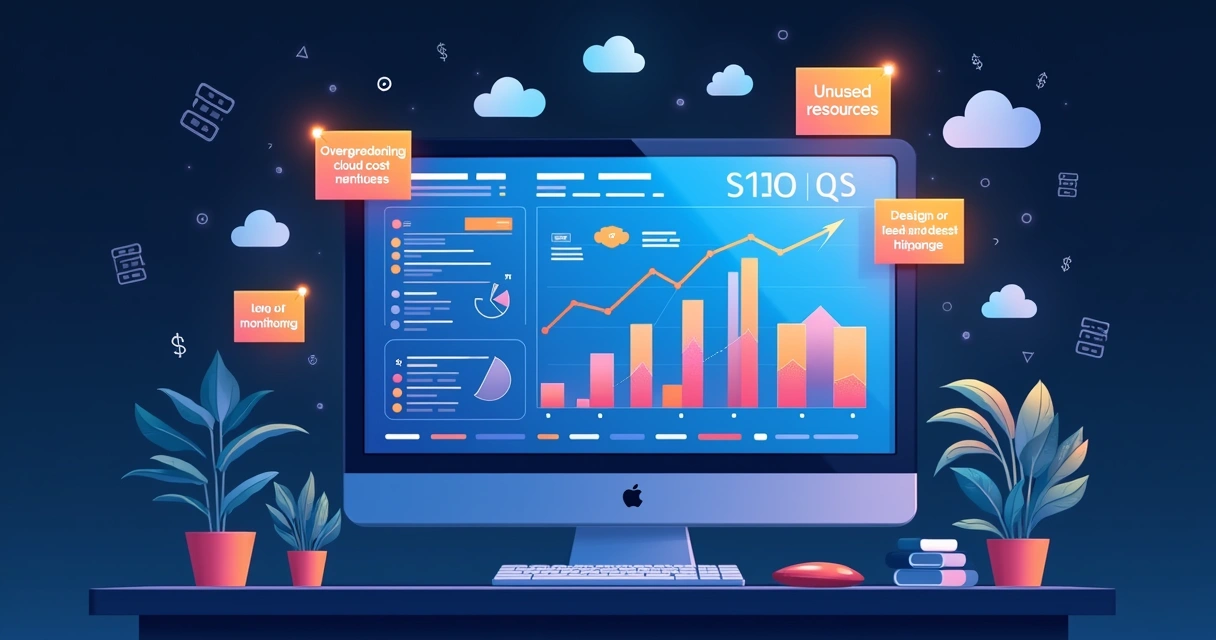There’s something a little humbling about that first shock of a cloud bill. You check, you check again, and it’s still as high as ever—and no, there’s no bug in the provider’s UI. Even in Arthur Raposo’s community, those who live and breathe robust back-end architecture or AI microservices, almost everyone has a story about finding, too late, a growing hole in their cloud budget. Why does it keep happening, year after year? Because cloud cost is a moving target—and 2025 will be even trickier.
Let’s look at the 13 cloud cost mistakes—it’s a weird number, but it fits—that are tripping even the most experienced teams. Some of these you might recognize, others might catch you off guard. Maybe, as you read, you’ll spot something that saves your budget—or your weekend.
Overprovisioning for comfort
It feels safer to ask for “just a little headroom.” Most teams want to make sure their systems never crash, so they request more CPU, memory, or storage than they actually use. But did you know that overprovisioning directly leads to massive cloud waste? In 2024, organizations are expected to lose roughly $135 billion on unused public cloud capacity, with containerized applications seeing as much as 60% overspend when teams err on the side of comfort, as reported by Alphaus Cloud.
More isn’t always better—sometimes, it’s just more expensive.
Right-sizing takes time. Yet, in practice, the savings are hard to ignore. Arthur Raposo’s guides often lay out hands-on cases showing the fine line between safe allocation and costly bloat—take a cue from those. Automate rightsizing reviews if you can.
Forgetting old resources
Ever spun up an environment for a quick test, then forgot about it? Most of us have. Those forgotten VMs, dangling storage buckets, or orphaned load balancers quietly generate bills every month.
Regularly audit both compute and non-compute resources. Maybe set a calendar reminder—sounds old school, but it works. Or, if you deal with larger cloud estates, use automated resource inventory checks.
Skipping reserved instances or savings plans
If your workloads are steady, relying only on on-demand pricing is like choosing to leave money on the table. Reserved instances and savings plans can save you up to 70% for predictable usage—yet too many teams skip them, unsure if they’ll ‘lock themselves in’ too soon.
Test-drive these options. Even committing 30-50% of your steady workload can make a clear dent in your costs.
Ignoring spot instances
Spot instances can be 80-90% cheaper—unbelievable, but true. Are they risky? A little. But for stateless jobs or CI pipelines, why not?
Try running batch processing or test environments on spot resources. Sometimes they’re unavailable, yes, but that’s manageable with a bit of automation.
Not watching data transfer costs
It’s easy to forget, but data leaving your cloud provider (data egress) can add up fast. For reference, Apple spent $50 million in one year just on data transfer fees. That’s not an outlier—this happens to plenty of companies that don’t pay attention to data egress rates, cross-region traffic, or inter-cloud migrations.
- Set budget alerts for data transfer.
- Review egress charges every billing cycle.
- Avoid unnecessary cross-region traffic—keep resources close together when possible.
Ask yourself: where is your data going, and do you really need it to?
 Lacking a finops strategy
Lacking a finops strategy
If you haven’t started thinking about FinOps, you’re falling behind. FinOps (finance + DevOps) means treating cloud spend as a cross-team responsibility from the start. McKinsey research highlights that teams with mature FinOps from day one see a 15-25% economic upside over time.
Bring finance, engineering, and leadership together—at least monthly—for a reality check. Share metrics. Discuss forecasts. Learn, adapt.
Failing to automate cost monitoring
Manual monitoring is unreliable. You forget. Reports get delayed. Patterns slip through the cracks. Automation changes that—alerts, real-time dashboards, daily emails on spend.
Arthur Raposo’s code repositories sometimes feature scripts for tagging, monitoring, and reacting to cost anomalies. Even a basic automated cloud report can stop a slow leak before it becomes a flood. According to Amnic’s study, not automating cost reporting is a frequent miss, creating gaps in cloud transparency.
Ignoring cost allocation tags
Cloud bills are often a jumbled mess until you add tagging. Teams, projects, environments—everything needs a tag. No tags, no clarity. You end up arguing in meetings about whose resources that pricey volume belongs to.
- Standardize tagging across all resources.
- Auto-enforce tags with policies, if your cloud allows.
- Revisit old untagged resources, even if it’s just once a quarter.
What isn’t tagged, isn’t managed.
Wasting time with unused reserved capacity
Reserved resources save money—unless you overcommit. Suddenly, you’re paying for idle capacity. This is the awkward side of long-term planning. Reevaluate your reserved resources at least twice a year, and if possible, use the provider’s marketplace to resell unneeded reservations.
Choosing the wrong storage tier
Paying for SSD performance where you only need cold storage? S3 Standard for log backups? It’s easy to pick the default tier, even when it doesn’t fit. Storage costs creep up quietly, often missed in preliminary cloud architecture talks.
Review your storage access patterns. Archive what you don’t need frequent access to. Move hot data to fast storage, leave logs in the cheapest tier.
Managing multi-cloud without a plan
More companies jump into multi-cloud or hybrid-cloud setups for redundancy or flexibility. But each platform doubles (or triples) your tracking effort. CloudKeeper’s experts note this is becoming one of the top reasons cloud cost management turns chaotic overnight.

Skipping regular cost reviews
Cost management is not a “set and forget” task. Cloud pricing, offers, and your own workload patterns shift every month. Ongoing reviews with cross-functional representation help you react before surprises appear on the bill.
Not involving developers early
The people spinning up resources need skin in the game. Without developer buy-in, you get shadow IT, accidental waste, and missed savings. In Arthur Raposo’s community, code samples and architecture reviews regularly highlight how developer education leads to better, more cost-aware deployments.
Run cost training sessions. Encourage engineers to test the financial impact of architectural decisions as soon as possible.
Treating cloud cost as ‘just an ops problem’
Cloud is everyone’s business—especially cost. If only operations teams review bills, you miss so much context. It’s easier for engineers and architects to notice patterns, suggest automation, and recommend architecture changes that actually reduce spend.
If cloud cost is everyone’s problem, everyone wins.
Conclusion
Cloud cost mistakes aren’t just about wasted money—they’re about missed opportunities. By paying attention to these 13 pitfalls, teams can shift from just reacting to costs, to guiding real business decisions, and building something resilient and sustainable. At Arthur Raposo, the focus is on bridging practical know-how, code, and architectural best practices—because cloud mastery isn’t theory, it’s teamwork, review, and that willingness to ask, “why are we paying for this?” Ready to build your cost-aware culture? Explore Arthur Raposo’s guides, and turn your architecture into your sharpest tool.
Frequently asked questions
What is cloud cost management?
Cloud cost management means tracking, controlling, and forecasting spend in cloud environments. It involves tools, policies, and team habits to avoid unexpected bills. Good management helps you predict future costs and keep everyone—from developers to finance—aware of what’s being spent and why.
How to reduce cloud costs fast?
Start by identifying idle and unused resources, then delete or downsize them immediately. Next, right-size provisioned resources and move data to cheaper storage. Review and apply discount options like reserved or spot instances, and tag all resources for easier tracking. Fast changes usually come from deleting or reconfiguring what you don’t actually need.
What are common cloud cost mistakes?
Common mistakes include overprovisioning, forgetting old resources, not taking advantage of savings plans, ignoring data transfer charges, missing out on automated monitoring, skipping tagging, and not involving developers or finance teams in regular cost reviews. Multi-cloud complexity and inappropriate storage tiers also frequently lead to budget overruns.
Is cloud cost management worth it?
Yes. Small changes in cloud cost habits can add up to big savings. Consistent management protects against surprises and gives you more control over your budget. Most companies who take cloud cost seriously report double-digit savings long-term—sometimes as much as 25% better cost performance, as found by various studies.
How can I track cloud spending?
Use your cloud provider’s built-in tools for cost tracking and alerting. Set up automated reports, enforce tagging, and review usage by project or team. Periodically, compare actual spend to forecasts, and adjust as needed. For multi-cloud, consider third-party tools that aggregate your costs for better visibility and control.



 Lacking a finops strategy
Lacking a finops strategy
Leave A Comment